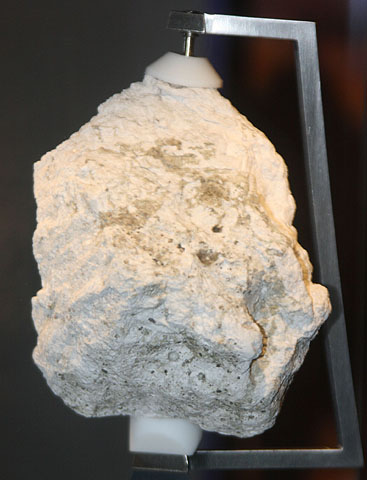Anorthosite is a fascinating rock and sparks interest even among those who usually don’t care about rocks. The reason is simple. Anorthosite is often composed of mineral labradorite which is famous for an iridescent effect called labradorescence. You’ll find more in this article: anorthosite and labradorescence.
The Moon highlands seem to be composed of anorthosite. We have both indirect and direct evidence for that. Measurements made recently by the Japanese lunar orbiter SELENE suggest that the lunar anorthosite may in many cases be almost totally monomineralic — composed entirely of plagioclase with very high calcium content. We have direct evidence also — American astronauts who visited Moon in the early 1970s brought back 61 rock samples that were found to be anorthosites.

Lunar anorthosite. Image: U.S. National Museum of Natural History.
It is wonderful to think that large portion of the Moons surface (highlands surrounding the basalt lowlands or marias) is schillering like anorthosites here on Earth often do. However, it is likely not the case. There are several differences between terrestrial and lunar anorthosites. Terrestrial anorthosites contain more sodium (sodium and calcium can replace each other in all proportions in the crystal structure of plagioclase). Plagioclase must have the composition of labradorite — one of plagioclase minerals. It means that 50-70% of the sites in the crystal structure which are occupied either by calcium or sodium ions are occupied by calcium. In the lunar anorthosites Ca-content is close to 100%. In order to have a labradorescence, the percent of calcium needs to be in the range of 48-58%. The effect of labradorescence is the result of a breakup of plagioclase crystals into many alternating lamellae of different (calcium and sodium rich) composition. If there is very little sodium present, such exsolution simply can not take place.
There are more differences between terrestrial and lunar anorthosites. Lunar anorthosites are light-colored, while some terrestrial anorthosites are dark. Here on Earth the cooling of anorthositic magma bodies took very long time. The crystals which show labradorescence are often very large, even pegmatitic (more than an inch in length). Lunar anorthosites, however, are quite fine-grained. Only very few crystals are larger than 1 cm.
Lunar anorthosite is very old. It is believed that it formed when the lunar magma ocean solidified which probably took place in the first 100 million years of the existence of the Moon. Lunar anorthosite is believed to be the result of a gravitational differentiation. Plagioclase is lighter than most other minerals found there and therefore rose to the uppermost part of the magma ocean. However, the details of this process are still hotly debated.
Take a look at the NASA Lunar Sample Catalog if you want to see more images and general overview of the rocks collected by the astronauts of the Apollo program.
NASA actually have it’s samples on the web. Not the most convenient form for viewing but still… http://curator.jsc.nasa.gov/lunar/samplecatalog/index.cfm
Thanks, Liene. I thought that something like that has to exist but couldn’t find it. By the way, I really liked your post about the metamorphic rocks in Bergen area.
Thanks! I plan to write more on metamorphism when get some results from the lab.